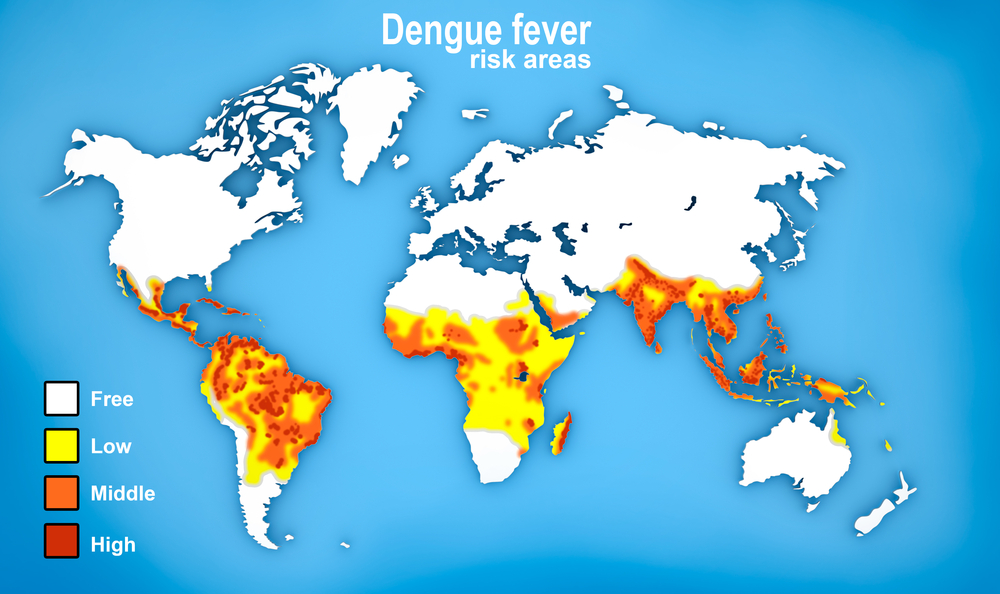Table of Content
TogglePrevention and Vaccination
Avoiding Mosquito Bites
Preventing dengue fever largely depends on avoiding mosquito bites, especially in regions where the disease is prevalent, such as Africa, Asia, and Central and South America. Applying mosquito repellents containing DEET, picaridin, or IR3535 can help protect against bites. Wearing long-sleeved shirts and pants, as well as using mosquito nets while sleeping, can also reduce the risk of being bitten.
Another essential step in reducing exposure to dengue-carrying mosquitoes is to remove standing water sources near homes, as these are prime breeding grounds for mosquito populations. Covering water containers, regularly cleaning gutters, and properly disposing of cans, bottles, and other water-holding objects can help control the mosquito population.
Dengue Vaccine
A dengue vaccine named CYD-TDV has been developed and has shown some protective efficacy against severe dengue fever. Protective efficacy rates are as follows:
| Outcome | Protective Efficacy (%) |
|---|---|
| Severe Dengue Fever | 93 |
| Any Grade Dengue Hemorrhagic Fever | 93 |
| Hospitalization due to Dengue | 81 |
The vaccine has not yet been approved for use in all countries. However, its development marks an important step in the battle against dengue fever. It is essential to continue researching and developing novel vaccine strategies for more effective disease prevention.
In conclusion, the key to preventing dengue fever is a combination of mosquito bite prevention techniques and the eventual widespread use of an effective dengue vaccine. When applied together, these methods have the potential to significantly reduce the global burden of dengue fever.
Global Overview of Dengue
Dengue fever is a mosquito-borne viral infection affecting people worldwide, primarily in tropical and subtropical regions. An estimated 100-400 million dengue infections occur each year, with a significant global burden in terms of morbidity and mortality.
Endemic Regions
Dengue fever is endemic in more than 100 countries, including:
- Southeast Asia: This region registers the highest number of dengue cases worldwide, with countries like Indonesia, the Philippines, and Vietnam being severely affected.
- Southern China: Several outbreaks have been reported, particularly in the Guangdong province.
- Mexico & U.S. Territories: Dengue is endemic in Mexico, while U.S. territories such as Puerto Rico and the U.S. Virgin Islands also report cases.
- Pacific Islands: Countries like Fiji and Solomon Islands witness regular outbreaks.
- South and Central America: Many countries, including Brazil, Ecuador, and Peru, experience periodic epidemics.
Travelers visiting these endemic areas are at an increased risk of contracting dengue fever. It is crucial for them to take preventive measures, such as using mosquito repellents and wearing protective clothing.
Incidence in the United States
While the continental United States is not classified as an endemic area, sporadic cases of dengue fever have been reported in states like Florida and Texas, primarily among travelers returning from endemic regions. In recent years, local transmission has also been observed. The World Health Organization (WHO) continues to monitor the global distribution and spread of dengue fever, with a prime focus on reducing the infection’s impact in affected areas.
Emerging Challenges in Dengue Control
Comorbidity with Other Viral Diseases
Dengue fever, a mosquito-borne viral infection, has been facing increasing challenges due to the coexistence and comorbidity with other viral diseases such as Zika, Chikungunya, and Yellow Fever. These diseases share the same Aedes mosquito vector, leading to more complex and intertwined epidemiological situations. Concurrent infections with multiple viruses can result in more severe symptoms and complications, making it harder for healthcare systems to manage and control these outbreaks.
Increasing Incidence
Over the past decades, there has been a significant increase in dengue outbreaks worldwide. Factors contributing to this increase include urbanization, population growth, increased global travel, and climate change. These factors have enhanced the range and breeding grounds of Aedes mosquitoes, leading to a higher risk of infection.
| Year | Reported Dengue Cases |
|---|---|
| 1990 | 1,240 |
| 2000 | 5,500 |
| 2010 | 22,000 |
| 2020 | 50,000+ |
As the table above illustrates, the number of reported dengue cases has increased dramatically over the years. This surge in cases presents significant challenges for dengue control efforts. For example, the rising incidence of dengue fever results in overwhelmed healthcare systems, an increased need for diagnostic tools, and resource allocation for prevention and control measures.
Moreover, dengue fever symptoms – such as high fever, severe headache, joint and muscle pain, and fatigue – can also resemble those of other viral infections like Zika, Chikungunya, and Yellow Fever. This overlapping clinical presentation makes it more difficult for healthcare professionals to accurately diagnose and treat patients.
In conclusion, emerging challenges in dengue control include the comorbidity with other viral diseases and the increasing incidence of dengue fever cases. These challenges call for continuous research, development of new diagnostic tools, and innovative prevention and control strategies to combat dengue and other mosquito-borne viral diseases effectively.
Frequently Asked Questions
What causes dengue fever?
Dengue fever is caused by the dengue virus, which is transmitted to humans primarily through the bite of an infected Aedes mosquito. There are four distinct serotypes of the dengue virus, and infection with one serotype does not provide lifelong immunity to the other serotypes.
What are the first signs of dengue fever?
The first signs of dengue fever usually appear 4-7 days after being infected and may include a sudden, high fever, severe headaches, pain behind the eyes, joint and muscle pain, nausea, vomiting, and fatigue. These symptoms can also be accompanied by a mild rash.
How is dengue fever diagnosed?
Diagnostics for dengue fever typically include blood tests to detect the presence of the dengue virus or antibodies produced in response to the infection. A complete blood count (CBC) may also be performed to assess the severity of the illness.
What does the dengue fever rash look like?
The dengue fever rash usually appears after the initial symptoms have started and is characterized by small red spots or a blotchy, red eruption covering the body. This rash may be accompanied by itching and usually lasts for 2-5 days.
What medications are used to treat dengue fever?
There is no specific antiviral medication for the treatment of dengue fever. Treatment primarily focuses on relieving symptoms and ensuring proper hydration. Over-the-counter pain relievers, such as acetaminophen, can be used to reduce fever and alleviate pain. Aspirin and nonsteroidal anti-inflammatory drugs should be avoided due to the risk of bleeding complications.
How can dengue fever be prevented?
Preventing dengue fever largely involves reducing the risk of exposure to infected mosquitoes. This includes the use of insect repellent, protective clothing, and mosquito nets, as well as eliminating mosquito breeding sites, such as standing water, around homes and communities. In some regions, a dengue vaccine is also available for certain age groups as an additional preventive measure.












